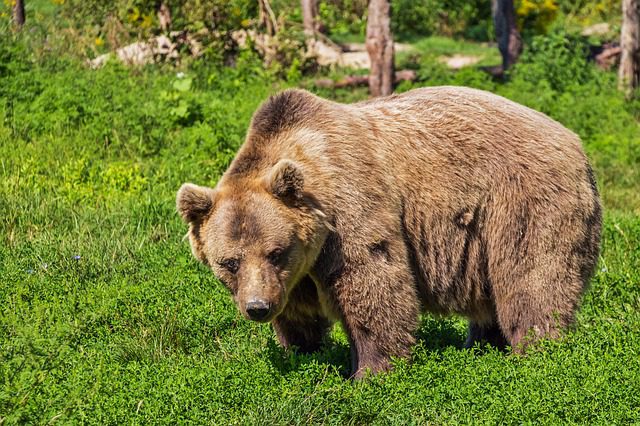
Why bears live in the forest: why is it attractive to them
Since childhood, many of us have been interested in the question of why bears live in the forest. After all, we have become accustomed since our acquaintance with fairy tales that these animals come out of the forest with a solid clubfoot gait. Why is this area so attractive for bears? And do all of them live in it?
Contents
Why do bears live in the forest: what makes him attractive to them
Forest for most clubfoot – familiar habitat. I mean brown bear, black, malay, spectacle bears. Even panda loves the forest because bamboo really forms whole thickets.
И that’s what the forest area is for bears good:
- When answering the question of why bears live in the forest, one must first remember that there is a huge amount of food for bears in the forest. For example, berries, fruits, nuts, insects – all this is in abundance in autumn. But it is in autumn that the bear becomes the most active, tends to eat more. Still: ahead of hibernation! And it can not be survived without a huge amount of stored nutrients. Even bird eggs are happily eaten by bears. Tree bark is also a great treat. No other habitat provides as many healthy, satisfying treats as the forest.
- Sometimes the clubfoot takes prey from weaker predators. For example, in wolves, lynxes, etc. In this case, of course, it is more comfortable for him to live where these predators live. Such appropriations of prey happen infrequently, but in especially hungry times, the bear does not shun robbery.
- Bears also need grass and needles. Oddly enough, the bear also eats them! True, after hibernation – in the spring – when you need to restore strength by any means.
- When winter comes, the bear just needs shelter! And in the forest it is best to build a lair – there you can equip a suitable dwelling under the roots or in some other secluded place. The den site should be secluded, quiet, dry and lined with moss. Sometimes the height of the moss bedding reaches several meters! Bears have been using especially cozy dens for generations. It is also most convenient to confuse the tracks in the forest – the bear diligently does this before going into hibernation.
What bears do not live in the forest and why
А what kind of bears do not live in forest thickets? It’s white the Bears. Forest thickets are absolutely not for them fit for food. Berries, nuts, insects and fruits are completely not interesting. And prey that lynxes get for themselves, wolves, they don’t need it either. In the woods it would be perfect for a polar bear to eat nothing.
This bear feeds on seals – it sneaks up to the hole and waits for its prey to be within reach. And even better, she got out on the ice. Then the bear instantly hits it with its paw. Agility this animal does not hold, although it is sometimes hard to believe. The polar bear is actually a fairly agile and cunning predator that knows how to hunt. True, again, only for seals. With other food, familiar to other bears, he would not know what to do.
IMPORTANT: In addition, the white coat color will make the bear very recognizable in the forest area. In winter, of course, he could still disguise himself, but not at other times of the year.
And what can be said about the lair? How does the polar bear cope with this in snow and ice conditions? A bear needs a den only for breeding. There is no such thing as “hibernation” in this breed. After all, this animal just feels great in the cold thanks to an excellent fur coat and paw pads adapted to the cold. That is, the polar bear does not need to hide somewhere in order to survive the cold – in a word, the forest is useless here too.
But what can be said about the lair, in which produce offspring? Created by her bear on the shore, in the ice dunes. That is, there where there is a lot of snow. In case of emergency icy soil is also suitable – powerful claws bears can handle it too. But in any case forest nooks with a bunch of Polar bears don’t need moss.
Such concepts like “bear” and “forest” seem inseparable. And this is how we found out not by chance. In the same way, it turned out that not all bears are forest dwellers. We hope our article helped. expand the horizons of our readers in this issue.





